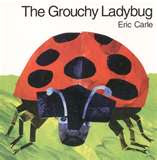Author: Eric Carle
Illustrated: Eric Carle
Published: 1996
Publisher: HarperColins Publishers
Interest Level: K-2
Reading Level: J
Plot: Circular/Cumulative
Theme: Implicit
- You certainly are left to infer why the lady bug does not fight the other animals, and simply flies away.
Genre: Fantasy/Picture Book
What is a Circular/Cumulative Plot Anyway?
When a story is made up of phrases, or events that repeat with new things added each time. Image this story as a bunch of widening circles.
The "grouchy" lady bug meets asks the "friendly" lady bug to fight. The "friendly" lady bug answers with a simple
"If you insist"
It is safe to infer that the lady bug was scared or simply did not want to fight by its reply of
"Oh, you're not big enough for me to fight"
The "friendly" lady bug only tell his to go find someone bigger, and to prove some point the "grouchy" lady big does. We see the lady bug as he flies all over asking bigger, and bigger animals to fight repeating this same dialogue.
Until the ladybug is finally meets a whale's tail who gives him a slap right back to the place he started. The "friendly" lady bug welcomes him back, and allows him to enjoy a nice dinner. I think it safe to say that the "grouchy" ladybug has a new outlook on life.
Characters:
They are simple and have simple characteristics. One ladybug is friendly, and one is grouchy. The other animals only have the characteristic that they are ready to fight.
Vocabulary:
The ladybugs are talking about Aphids. I had no clue what a Aphid was so I figured that I would let everyone know that:
Aphids are very small insects. They such the juice from the leaves and then the leaves die. This is why it is good to have ladybugs, because they eat the Aphids.(Carle)
Is there more to this book that meets the eye?
This book teaches time. Every time the ladybug meets a new animal it gives the time on a small little clock in the right hand corner. It allows a the reader to see what that certain time looks like on a clock.
A great activity would be to make a bigger clock so that if this book is read aloud to a large group of kids you can move the hands around at each encounter.
Carle, E. The grouchy ladybug. 1996. Print.

No comments:
Post a Comment